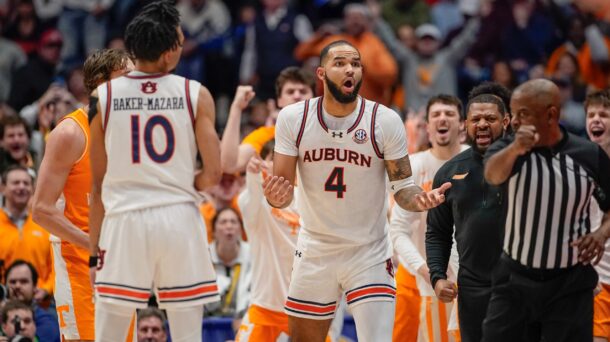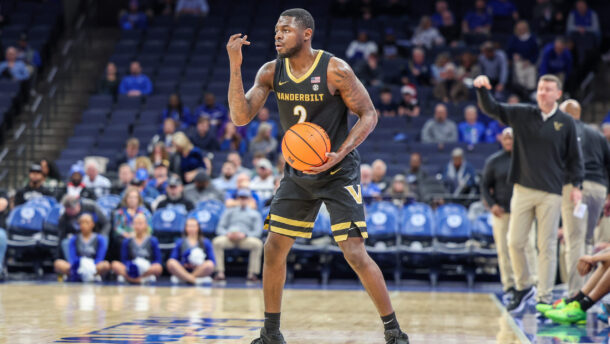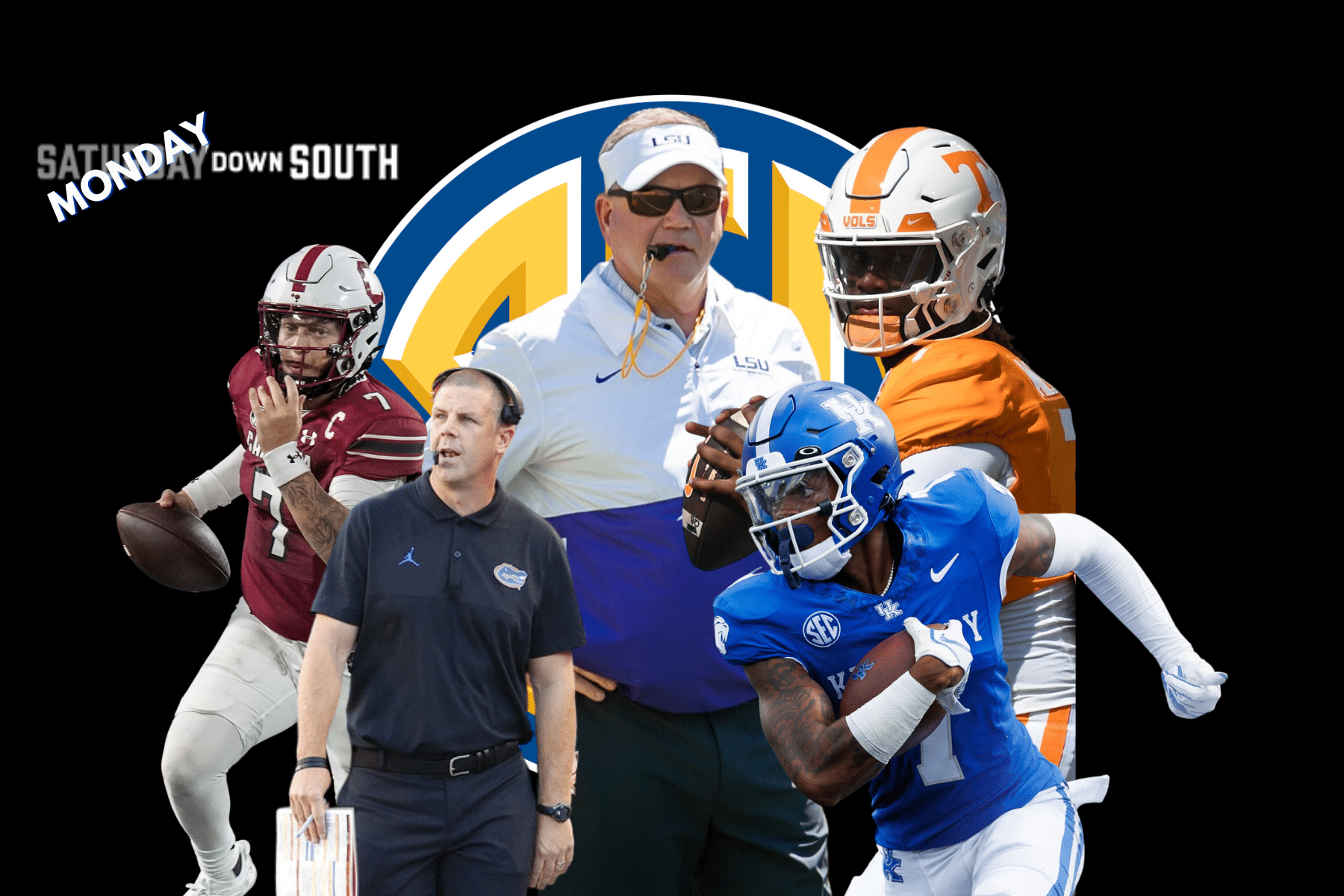
Back on March 1, it looked like Auburn had college basketball figured out.
The Tigers were 27-2 overall and 15-1 in SEC play and fresh off of a dominant double-digit win at Rupp Arena in Lexington.
But life comes as you fast in college hoops, and even faster still when the calendar flips to March. Since that memorable win over Kentucky, Auburn has lost 3 of its last 4 games.
The results are what they are. An 11-point loss in College Station. An overtime defeat to Alabama on Senior Day. An unimpressive win over Ole Miss in the SEC Tournament. And a narrow disappointment to Tennessee in the semifinals.
What matters now is whether or not Auburn can get back off the mat after facing its first real adversity of the 2024-25 season. Did Auburn just take its foot off the pedal after 4 months of dominant basketball? Or have the Tigers been solved to some extent?
Let’s take a look at the data and some recent March Madness trends.
What’s different about Auburn in March?
The first thing to note is that Auburn has absolutely earned its 1-3 record over the past couple of weeks. According to BartTorvik, the Tigers are 35th in the country since March 2. So even though its recent losses have been in close games to good teams, this is an Auburn squad that is performing nowhere near its peak as the NCAA Tournament begins.
Here’s where Auburn ranks nationally in some key categories before and after March 1, according to data from BartTorvik:
Most of Auburn’s issues on offense trace back to 1 thing: the Tigers aren’t making as many shots as they were earlier in the year.
But it’s worth noting that Auburn’s schedule-adjusted offensive rating has only dipped below 119 for one of these 4 games in question — and that was the one the Tigers actually won against Ole Miss. By and large, Auburn has put up workable offensive numbers over this slump (after adjusting for opponent strength).
That defensive rebounding rate can be explained, too. For one, Auburn wasn’t all that good at defensive rebounding to begin with. That’s not ideal, but it’s a survivable flaw when the rest of the profile is as good as it’s been this year.
The more impactful factor, though, was the A&M game. The Aggies are the No. 1 offensive rebounding team in the country and then put up an O-Board rate of 60% against Auburn. That’s atrocious — but it’s just one game. In the other March games, Auburn’s defensive rebounding rate is roughly in line with its season average.
The shot-making is something to keep an eye on. The Tigers went exactly 6-for-21 from 3-point range in both of their SEC Tournament games. But there’s a large enough sample size on Auburn being a good 3-point shooting team that I’m not ready to predict its downfall based on 2 bad games in a row. But when you combine all of these bad trends into a condensed timeframe, a slump can emerge.
How predictive are pre-tournament results?
BartTorvik’s model goes back to 2008, so we can look at some previous seasons to see if an early-March swoon is abnormal for elite teams.
In 2024, UConn, the eventual national champion, was the best team in the country per BartTorvik’s power ratings from March 3 through March 17. Houston and North Carolina, 2 other No. 1 seeds, were both in the top-6 during this stretch and made the Sweet 16. Purdue, who reached the title game, was down in 11th. Notably, Auburn was the No. 2 team in the country over this stretch but still got upset by Yale in Round 1.
In 2023, 1-seeds Purdue (14th) and Kansas (35th) were both well outside the top 10 from Feb. 26 through March 12th and each suffered embarrassingly-early exits from the NCAA Tournament. The other 1-seeds, Alabama and Houston, each made the Sweet 16 but were ranked 7th and 16th, respectively, over this span. UConn, the eventual champion, was 2nd over this span.
In 2022, 1-seed Kansas won the national title and was 8th overall in BartTorvik’s rankings between Feb. 27 and March 13. No. 1-seeded Arizona made the Sweet 16 after being ranked 19th during those dates. Baylor was 24th and didn’t reach the 2nd weekend. Gonzaga was the final No. 1 seed that year and was ranked No. 1 by BartTorvik over this stretch, but it’s worth noting the Bulldogs only played 2 games during the period.
It’s possible this is all small sample size theatre. But how a team is playing going into March does seem to have at least some impact on their performance in the Big Dance — at least over the last 3 years. In 2021, it was much more random. Baylor won the title after being rated just 20th over the final 2 weeks before Selection Sunday. Another 1-seed, Michigan, made the Elite Eight after slotting in at No. 44 over that same period.
With all of that being said, here are a couple of admittedly cherry-picked trends from this research: the last No. 1 seed to reach the Final Four after being ranked outside the top-25 in BartTorvik’s power ratings in the 2 weeks prior to Selection Sunday was North Carolina back in 2009 (Carolina won it all that year). A few others who fit that criteria reached the Elite Eight, but UNC is the only one who made the Final Four.
There’s also this: in the last 10 NCAA Tournaments, there have been 5 No. 1 seeds who ranked outside of the top-20 in BartTorvik’s power ratings in the 2 weeks prior to Selection Sunday. Those 5 teams averaged 2.2 wins in their respective tournaments and none made it further than the Elite Eight. If you loosen the criteria to top-15, there are 9 teams who make the cut. Those squads averaged just 2.7 wins per tournament, and that includes Baylor’s national title run in 2021.
Auburn’s path to the 2025 Final Four
The Texas A&M game is bad enough to be concerned about Auburn in the NCAA Tournament against any team that crashes the offensive glass and plays good defense. There are some teams who fit that mold, but Auburn won’t run into one early.
At the risk of jinxing the Tigers, we’ll assume they get past their No. 16-seed matchup. In Round 2, neither Louisville nor Creighton are anywhere close to elite on the offensive glass. The Cardinals and their top-20 defense probably profile as a tougher matchup for Auburn, but neither of these games would particularly frighten me if I was an Auburn fan.
Further down the draw, Auburn would get one of Texas A&M, Michigan, UC San Diego and Yale if they reach the Sweet 16. We’ve talked about the Aggies already — that would be potentially disastrous for Auburn. That possible matchup alone would scare me off of betting on Auburn to go on a deep run. Michigan has an elite defense. Yale is an awesome 3-point shooting team who led the Ivy League in offensive rebounding rate. UC San Diego is hilariously under-seeded based on its predictive metrics, although I think Auburn would have a pretty big stylistic advantage against a Tritons team that allows tons of 3-point attempts and doesn’t hit the offensive glass.
Auburn’s Final Four odds currently sit at around -140 at most books. Even while acknowledging its red flags, I’m a buyer in Auburn to make the Sweet 16 at -380 (via bet365). If the Aggies get knocked out early, then perhaps Auburn is in good position to reach the Elite Eight and face off against Michigan State, Iowa State or another team from that part of the bracket. Beyond that, I’m pretty skeptical Auburn can regain what it appeared to have earlier this season.
Spenser is a news editor for Saturday Down South and covers college football across all Saturday Football brands.






